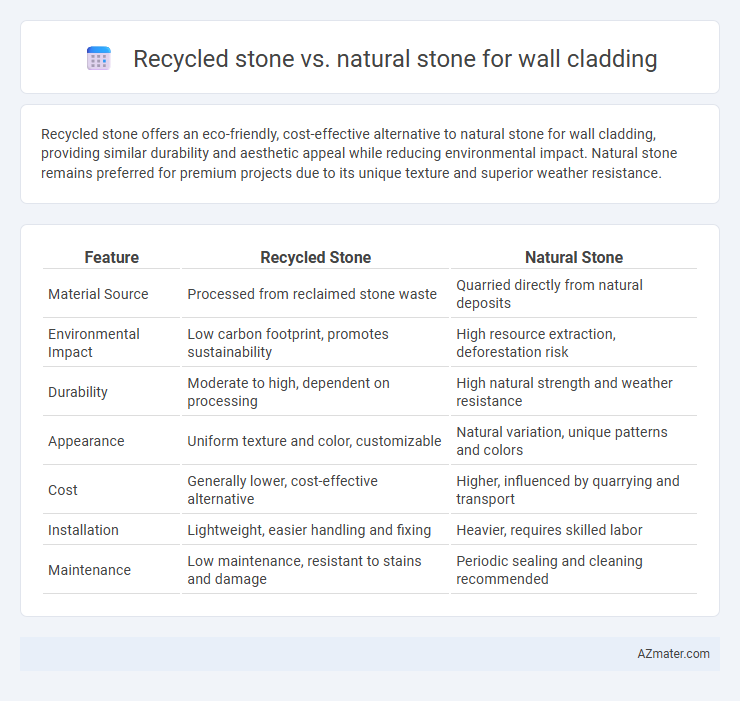Recycled stone offers an eco-friendly, cost-effective alternative to natural stone for wall cladding, providing similar durability and aesthetic appeal while reducing environmental impact. Natural stone remains preferred for premium projects due to its unique texture and superior weather resistance.
Table of Comparison
| Feature | Recycled Stone | Natural Stone |
|---|---|---|
| Material Source | Processed from reclaimed stone waste | Quarried directly from natural deposits |
| Environmental Impact | Low carbon footprint, promotes sustainability | High resource extraction, deforestation risk |
| Durability | Moderate to high, dependent on processing | High natural strength and weather resistance |
| Appearance | Uniform texture and color, customizable | Natural variation, unique patterns and colors |
| Cost | Generally lower, cost-effective alternative | Higher, influenced by quarrying and transport |
| Installation | Lightweight, easier handling and fixing | Heavier, requires skilled labor |
| Maintenance | Low maintenance, resistant to stains and damage | Periodic sealing and cleaning recommended |
Introduction to Wall Cladding Materials
Recycled stone and natural stone are popular materials for wall cladding, offering distinct environmental and aesthetic benefits. Recycled stone utilizes waste materials from demolished structures, reducing landfill impact and conserving natural resources, while natural stone provides durability and timeless beauty sourced directly from quarries. Selecting between recycled and natural stone depends on project sustainability goals, budget, and desired visual texture for exterior or interior wall applications.
What is Recycled Stone?
Recycled stone for wall cladding is made by repurposing crushed stone materials from demolition sites, concrete, and masonry waste, offering an eco-friendly alternative to natural stone. This material retains the aesthetic appeal and durability of natural stone while reducing environmental impact by minimizing quarrying and landfill use. Recycled stone provides sustainable wall cladding solutions with varied textures and colors comparable to traditional natural stone.
Defining Natural Stone Cladding
Natural stone cladding consists of quarried stone materials such as granite, limestone, marble, or sandstone, valued for their durability, aesthetic appeal, and unique natural textures. These stones undergo minimal processing to preserve their inherent characteristics, making them ideal for elegant, long-lasting wall facades. Natural stone cladding offers superior resistance to weathering and structural integrity compared to many recycled alternatives.
Sustainability: Recycled Stone vs Natural Stone
Recycled stone for wall cladding significantly reduces environmental impact by diverting waste from landfills and minimizing quarrying activities, conserving natural habitats and lowering carbon emissions associated with extraction. Natural stone involves extensive mining processes that disrupt ecosystems and consume substantial energy, contributing to higher greenhouse gas emissions. Choosing recycled stone supports sustainable construction practices by promoting resource efficiency and reducing the overall ecological footprint of building projects.
Aesthetic Differences and Design Versatility
Recycled stone offers unique textures and color variations due to its reclaimed origins, creating a distinctive, eco-friendly aesthetic for wall cladding. Natural stone provides a timeless, consistent appearance with a wide range of colors and patterns that enhance traditional and modern design schemes. Design versatility is higher with recycled stone because it can be customized and shaped, while natural stone excels in durability and classic elegance for diverse architectural styles.
Durability and Longevity Comparison
Recycled stone for wall cladding offers commendable durability, often matching or exceeding natural stone due to its engineered composition that resists cracking and weathering. Natural stone provides exceptional longevity, with materials like granite and slate enduring centuries of exposure with minimal degradation. Both options require proper installation and maintenance to maximize lifespan, but natural stone generally surpasses recycled stone in long-term resilience under extreme environmental conditions.
Cost Considerations: Upfront and Long-term
Recycled stone for wall cladding typically offers lower upfront costs compared to natural stone due to reduced extraction and processing expenses. Long-term, recycled stone may provide comparable durability but could require more frequent maintenance, potentially increasing overall costs. Natural stone commands higher initial investment but often delivers superior longevity and minimal upkeep, making it cost-effective over extended periods.
Installation Process and Timeframes
Recycled stone offers a lightweight, pre-cut design that simplifies the installation process and significantly reduces labor time compared to natural stone, which often requires custom cutting and heavier handling. Natural stone's installation typically involves longer timeframes due to its variability in size, weight, and the need for specialized tools and skilled labor to achieve proper alignment and adhesion. Choosing recycled stone can lead to faster project completion and lower labor costs, making it ideal for time-sensitive wall cladding applications.
Maintenance Requirements
Recycled stone wall cladding requires less maintenance due to its enhanced durability and resistance to weathering compared to natural stone, which may demand regular sealing and cleaning to prevent erosion and staining. Natural stone, such as limestone or sandstone, is porous and prone to moss or mildew buildup, necessitating frequent upkeep to maintain its aesthetic appeal. Choosing recycled stone reduces long-term maintenance costs while providing eco-friendly benefits without compromising visual quality.
Choosing the Best Option for Your Project
Recycled stone offers an eco-friendly and cost-effective alternative to natural stone for wall cladding, providing similar durability and aesthetic appeal while reducing environmental impact. Natural stone provides unmatched authenticity, unique textures, and long-term resilience, making it ideal for high-end projects that demand premium finishes. Choosing between recycled and natural stone depends on budget, design preferences, project sustainability goals, and the desired lifespan of the wall cladding.

Infographic: Recycled stone vs Natural stone for Wall cladding
 azmater.com
azmater.com